“At the head of it all is God, lord of heaven.
Then comes Prince Torlonia, lord of earth.
Then comes the armed guard of Prince Torlonia.
Then comes the hounds of the armed guard of Prince Torlonia.
Then nobody else. And still nobody else.
And still again nobody else.
Then come the farmers . . .”
A popular poem published in Ignacio Silone’s novel Fontamara, 1934, quoted by Charlie Fegan, Sainsbury Scholar in Painting & Sculpture, in a review of the Torlonia exhibition in the blog of the British School at Rome.

Giovanni Battista Piranesi, Palazzo Vidoni Caffarelli, 18th c., Public domain.
A highly important exhibition in Rome, Torlonia Marbles: Collecting Masterpieces, that was due to end June 29 has been extended until January 9, 2022. The exhibit is located in the newly renovated ground floor galleries of the Villa Caffarelli, part of the larger complex of the Musei Capitolini founded in 1734 by Pope Clement XII.
The extension of the exhibition date will give more of the public a rare opportunity to see selections from one of the finest private collections of classical sculpture extant. Equally important, the collection encapsulates the history of collecting classical art from the Renaissance onward. The exhibition tells the story of objects passing from noble family to noble family, often being restored in the fashion of the time or even remade to suit the desires of particular owners. Many of the sculptures in the collection were studied and published in the 18th century by Johann Joachim Winckelmann, a founder of art historical studies. Wincklemann’s publications, which included many objects now in the Torlonia collection, have inspired artists and historians through today, yet the original objects have been hidden for the last 70 years.

Crouching Aphrodite statue, replica of the Doidalsas type from the early 1st century AD from an original from the middle of the 2nd century BC, Torlonia Collection, formerly collection of Giustiniani. photo by Carlomorino, 5 February 2021, CCA-SA 4.0 International license.
The Torlonia collection, enriched by purchases of multiple earlier collections, has been solely in the hands of the family since the mid 19th century. The exhibition of 92 busts and statues is drawn from 620 ancient sculptures that had lain virtually abandoned in the Torlonia’s Villa Albani. Largely inaccessible since the end of the Second World War, parts of it have been seen by a few invitees (or people who bribed a caretaker) and then by ministry inspectors in the 1990s.
The exhibition has been anticipated for many years but given the strong personalities involved, a lengthy family feud over the division of assets, an even longer fight with the Italian government, the enormous value – aesthetic and monetary – of the works, and the inflexibility of Italian law, it is remarkable that it happened at all.
Coming from humble beginnings, the Torlonia family became princely landowners and financiers. Charlie Fegan wrote in the blog of the British School at Rome that, “The first noteworthy member of the family, who came from France to Italy in the eighteenth century, was Giovanni, a rag and bone merchant who became one of Europe’s greatest financiers for the Vatican.”
Giovanni Torlonia (1755-1829), who was ennobled to higher and higher status by Popes Pius VI and Pius VII, eventually became 1st Prince of Civitella Cesi, a Roman Patrician, and Duke of Poli and Guadagnolo. His descendants, most notably Alessandro Torlonia (1800-1886), who inherited his title as 2nd Prince of Civitella Cesi,, continued Giovanni’s enthusiastic collecting activities.
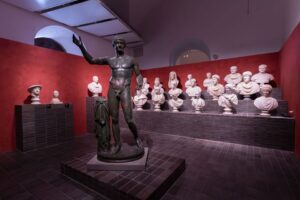
Installation view of The Torlonia Marbles: Collecting Masterpieces, Courtesy of Sky TG24/Corriere della Sera.
During the 19th century the Torlonias became the richest and one of the most powerful families in Rome. Prince Alessandro Torlonia of Fucino, head of the family until his death in 2017 is said to have greatly resented the claims of the Italian state against the collection. The family’s collection was located from 1874 until about 1948 at a private museum in their palazzo known as the Museo Torlonia. In the 1970s, the prince moved the collection to storage, virtually cutting off access, and eventually turned the building into tiny rental apartments, of course without seeking government permission.
(The first modern legislation on cultural property, Law 364 of 1909 created both a pre-emption right in favor of the State on the transfer of cultural property and allowed compulsory purchase by the State at its discretion of an owner who failed to comply with restoration.[1] Although this law applied primarily to monuments at that time, the Torlonia collection was ‘notified’ i.e. registered by the Italian government in 1910. The passage of a more comprehensive Law No. 1089 of 1939 only strengthened the hand of the Italian government against private owners.[2])
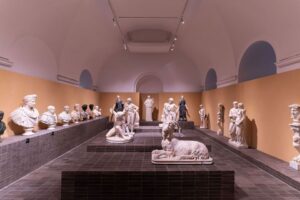
Installation view of The Torlonia Marbles: Collecting Masterpieces, including a 1st c. goat whose head is attributed to Gian Lorenzo Bernini Photo: Oliver Astrologo © Fondazione Torlonia.
According to Anna Somers Cocks, writing in The Art Newspaper, there was a government attempt first to buy and then to confiscate the collection in 2003. It has taken decades of negotiations between the family and the State, and the creation of the Foundazione Torlonia in 2014, headed by Alessandro Poma Murialdo, Prince Alessandro Torlonia’s grandson, to make the exhibition a possibility. Additional years of work were needed for restorations and the creation of a space for public display to make the exhibition a reality. The exhibition was curated by the classical scholar Salvatore Settis and Carlo Gasparri for the Foundazione Torlonia; it was designed by David Chipperfield Architects, Milan. The cleaning and restoration of the sculptures in the exhibition was paid for by luxury jeweler Bulgari, a major sponsor of the foundation.
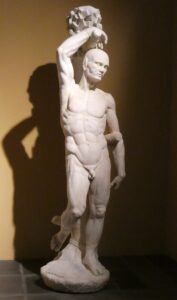
Statue of Marsyas, Flayed. Torlonia collection, photo by Carlomorino, 5 February 2021, CCA-SA 4.0 International license.
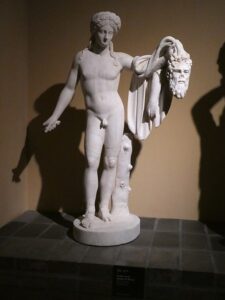
Apollo holding the skin of Marsyas. Torlonia collection, photo by Carlomorino, 5 February 2021, CCA-SA 4.0 International license.
The Torlonia Marbles, Collecting Masterpieces, catalogues in Italian and English, were edited by Settis and Gasparri and published by Electa. The catalog discusses the history of the collection and its most stellar objects. It also shows how the restoration and cleaning of the statues was undertaken as a means of understanding the processes of rebuilding and restoring classical works that took place over the last three centuries. Some reviewers have found the current ultra-white marble surfaces excessively bright and the lighting and placement of the statues on display too stark or too much of a contrast to more traditional exhibitions. Others have valued the different approach for its emphasis on making clear what is original and what is not, as well as for showing how the past manipulation of the sculptural parts illuminates the way in which art was seen and appreciated in earlier times.

Alessandro Torlonia with his daughter Anna Maria in 1876, photo by Antonio D’Alessandri, public domain.
The exhibition is laid out in five sections moving backwards in time, first describing the creation of the Torlonia museum in 1875 by Alessandro I Torlonia. The busts on the cover of the exhibition catalog, of a young girl and an elderly man, both discovered in 19th century excavations at Vulci and Otricoli, are displayed in this section together with a fine bronze statue of Germanicus. Tiers of shelves of portrait busts in white marble along the back wall echo the displays of multiple busts in the 19th century, when wealthy families collected such groups, often hoping to amass a complete collection of emperors and their wives.
The excavations and discoveries of antiquities in the Torlonias’ vast holdings of property in and around Rome are narrated in the second section. The outstanding piece here was discovered in 1863 at Portus Traiani – a large relief with offerings being made at a shrine to Bacchus at the top and the god Neptune with his trident in the lower section, surrounded by all sorts of activities on and around ships. Though the Torlonias were not very active excavators on their numerous properties in Rome and beyond: the Roma Vecchia on Via Latina, the Villa di Massenzio and Villa dei Quintili, as well as properties at Porto, Sabina and Tuscia all became sources for excavated artworks. The Torlonia’s business as financiers, lenders and debt collectors also enabled the acquisition of many other collections of artworks and even whole estates in lieu of payment.
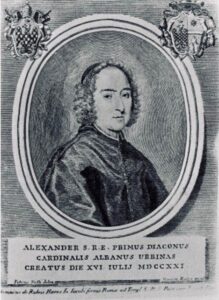
Cardinal Alessandro Albani.
The third section is focused on the tremendous collecting activities of the 18th century and the acquisitions of Cardinal Alessandro Albani (1692–1779). Albani’s librarian and adviser, Johann Joachim Winckelmann, was one of the most influential thinkers of the period. He is sometimes called both the Father of Art History and Father of Archaeology. Winckelmann’s writings are credited with awakening the taste for classical works that gave rise to Neoclassicism, and his severe criticism of blundering excavators helped to develop more scientific approaches to archaeology. His writing was the first to analyze the characteristics of classical antiquity and divide Greek works into periods and styles and to observe its transformations during the Roman Empire.
Here, there is an extraordinary mixture of objects from earlier collections, often restored or ‘recreated’ from pieces mixed from other sculptures and added to to meet the tastes of the late 18th century. These displays include many fine objects from the studio of the sculptor and restorer Bartolomeo Cavaceppi, from whom Alessandro’s father Giacomo Albani once purchased 1600 objects.

Statue of goat resting. The head was added by Bernini. ©FondazioneTorlonia. Ph. Lorenzo De Masi.
The fourth section displays the marbles collected by the 17th century nobleman Vincenzo Giustiniani and his brother Cardinal Benedetto – one extraordinary piece is a statue of a large resting goat with a ‘new’ head modeled and added by Bernini. The Torlonias are said to have acquired the Giustiniani collection in lieu of payment for a massive debt.
These crowded sections have a number of overwhelmingly large pieces, including two giant carved basins, tazze, one with a famous frieze of the labors of Hercules. The basin has been well-known since the 16th century through drawings but has barely been seen since it was absorbed into the Torlonia collection in the 19th century. This display leads to a final group of objects from Renaissance collections, completing the exhibition’s veritable history of classical collecting.
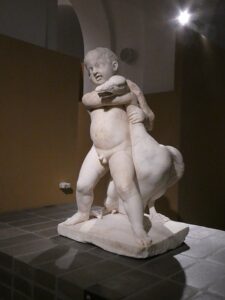
Replica of the Boy with the Goose by Boethos. Replica of the 2nd century AD. from an original from the end of the 3rd century BC, Torlonia collection, photo by Carlomorino, 5 February 2021, CCA-SA 4.0 International license.
Many scholars have raised concerns about the future preservation of the sculptures in the Torlonia collection that were not conserved and put on display in the exhibition. The pristine, brilliantly white surfaces of the objects on exhibit belie the conditions in which they have been kept for decades.
BBC correspondent David Willey describes a chance glimpse into the collection more than 40 years ago, when he rented a tiny apartment in the building that had once served as the Torlonia’s private museum. The Torlonia family had converted parts of what was originally a grain warehouse into 90 illegal, non-permitted spaces. Willey writes:
“I noticed a big steel door on my staircase. I asked the building superintendent what lay behind the door, and one day, after much insisting, he gave in and I was allowed a glimpse. “The prince would never allow anyone inside,” he whispered.”
“They were crammed higgledy-piggledy into a series of ill-lit strong rooms behind steel doors, and covered in dust, grime and rat droppings. It was a real shock to glimpse valuable and famous works of art in such a sorry, dirty, abandoned state.”
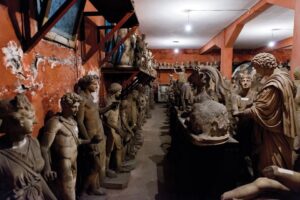
Conditions of storage of the Torlonia collection in 2015-16. Photo: Courtesy of Sky TG24/Corriere della Sera
Conservationists have been alarmed by disturbing photographs[3] from cataloging done by cultural ministry officials in 2015-2016. In them, the collection appears to be jammed together, covered in dust and grime and stored in derelict, damp spaces with peeling walls. It was reported that the entire collection was being stored in three rooms.
Even now, the artworks in the exhibition itself face an uncertain future. There is talk of building a new museum at Rome to house the collection but no final arrangement has been announced.
The Torlonia Foundation’s original agreement with Italy’s Ministry of Cultural Heritage and Activities and Tourism stipulated that there would be an Italian exhibition followed by an international tour. It was announced that the collection would eventually be housed in a new museum, to be situated in a building selected by the State and the Foundation, possibly the Palazzo Silvestri-Rivaldi or the Villa Albani Torlonia. The Palazzo Silvestri-Rivaldi is presently undergoing restoration to reinforce its floors, but there has been no announcement of where the collection will be housed in the future, or if the more than 500 other sculptures in the Torlonia collection will be restored (another 20 are said to have been cleaned in the last year) or become accessible to the public or to a broader scholarly view.
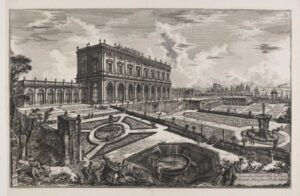
Giovanni Battista Piranesi, View of Villa Albani (1769).
Art critic, art historian and Italian politician Vittorio Sgarbi told The Art Newspaper that Italy should use some of the funding provided by the EU for covid recovery to buy the collection, which he estimated at €250 million. If the collection could be acquired for such a sum, it would be a bargain in comparison to the costs expended by the Carabinieri seeking repatriation of far less important works from abroad.
However, James Imam, writing in The Art Newspaper, states that the Fondazione Torlonia is not discussing selling the collection to the Italian state. Under Italian law, the owners of important artworks cannot export works outside Italy or even transfer them to another owner without the permission of the state required for all transfers.
Future foreign showings of Torlonia Marbles: Collecting Masterpieces also remain in doubt. The Torlonia Foundation said in June 2021 that the British Museum was not being considered as a venue. A possible showing at the Musée du Louvre has been delayed due to the covid-19 situation.
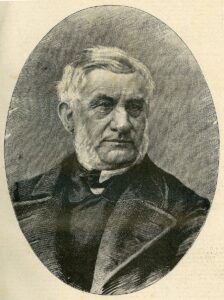
Prince Alessandro Torlonia, who died in 1886, L’illustrazione popolare, Fratelli Treves Editori – Milano, 1886
National politics and barriers related to constrictive Italian policies on foreign loans have sometimes led to poor relations with foreign museums. The Art Newspaper reported that in response to a question regarding the possible future display of the Torlonia sculptures at California’s Getty Museum, the Italian Ministry of Culture drew attention to the Getty’s dismissal of a decision by an Italian court. He said that the Getty’s bronze ‘Victorious Youth’ statue should be returned: “After the refusal of the Getty Museum to recognize the sentence of the Court of Cassation […] the Ministry has limited relations with the American museum to projects that have already been initiated.”
Yet loans to foreign museums from Italy are already difficult to get, extremely expensive, and too short in duration. Even wealthy American museums often find the process not only challenging, but impossible. The Association of Art Museum Directors gave testimony in 2020 to the Cultural Property Advisory Committee at the U.S. Department of State that the application and approval process was slow, cumbersome, and inconsistent, that longer loan terms were only available to U.S. museums that had repatriated objects to Italy, a quid pro quo, that exhibition fees, courier fees, and insurance costs were exorbitant, and that even private museums must obtain the Ministry’s approval to loan certain objects.[4]
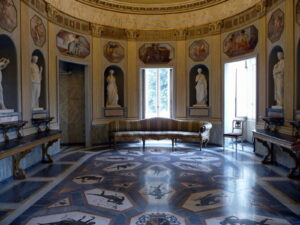
Villa Torlonia (Rome), interior, photo by Warburg, 17 April 2010, CCA-SA 3.0 Unported license.
Foreign loans to major museums aside, while the wonderful quality and the extraordinarily lengthy history of many of its sculptures give the Torlonia collection special meaning for Italy, there are also arguments for sharing both the pleasures and the admittedly great responsibilities and maintenance costs of such a collection with others. Sometimes, when conservation is scanty, funding chronically unavailable, and Italy seems to be drowning in classical artworks, it is tempting to imagine the educational contribution and aesthetic impact that such a collection would have if it could be transported whole to an institution in Asia, Africa, South America or the Middle East. Italy’s government should understand that Italian culture is in no way diminished by being exhibited and honored in venues around the world.
Regardless of its future placement, the uncertainty about the Torlonia collection’s future home and the likelihood that Italy will not look kindly on traveling exhibitions, the extension of the exhibition until January 9, 2022 will hopefully enable many more people from around the world to appreciate both the works and their collecting history at the Museo Capitolino in Rome.
[1] Law no. 364/1909 was formed of 42 articles and set out specific provisions covering: the definition of cultural property, which was extended to include any movable and immovable assets marked by historical, archaeological, paleontological or artistic interest, including manuscripts, incunabula, prints, inscriptions and numismatic goods; a general ban on transferring public cultural property belonging to the State and to any other public entities; the pre-emption right in favor of the State in relation to any transfer of cultural property; a compulsory purchase order of cultural property to be issued by the State (at its own discretion) in case of failure by the relevant owner to comply with the restoration obligation of cultural property set forth under Law no. 364/1909. Cecilia Carrara, Marialuisa Garavelli, Sara Colombera for Legance Avvocati Associati, Global Art and Heritage Law Series: Italy and the EU, Committee for Cultural Policy, Inc., at 10-11.
[2] “Law no. 1089/1939 was made up of 73 articles and – even though it failed to provide a clear definition of “goods of artistic and historical interest” and did not provide for the establishment of a central body dedicated to the protections of cultural property – it deserves to be appreciated even to date as it pursued the purpose of balancing the public interest in safeguarding cultural property and the private interest of their relevant owner. In addition, Law no. 1089/1939 has to be considered the key legislative text which has served as a groundwork for the Italian Laws for the protection of the cultural heritage in force to date.” Id. at 11.
[3] Trafug’Arte, a podcast series on Sky TG24, obtained photographs of the collection taken in 2015-16.
[4] Statement of the Association of Art Museum Directors Concerning the Proposal to Extend the Memorandum of Understanding between the Government of the Republic of Italy and the Government of the United States of America Concerning the Imposition of Import Restrictions on Categories of Archaeological Material Representing the Pre-Classical, Classical and Imperial Roman Periods of Italy, July 22, 2020, Meeting of the Cultural Property Advisory Committee, at 5-7.
Related article: “A Tale of Two Seizures: Antwerp, Basel, and the Carabinieri TPC – Is Italian policy changing focus from domestic crime to foreign collections?” Cultural Property News, July 20, 2021.
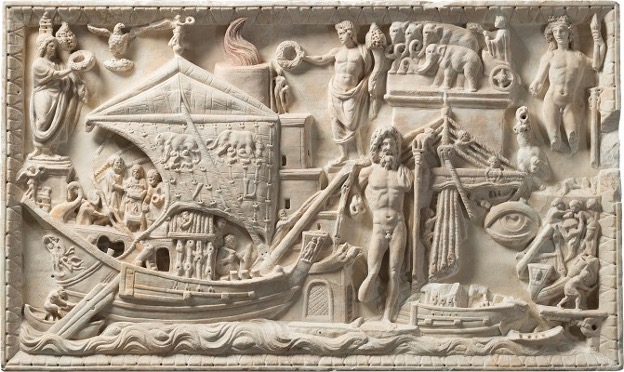 Ancient marble relief depicting Bacchus on right, Neptune standing with trident above a harbor with shipping activity, with traces of its original painted surface. Found at Portus. ©FondazioneTorlonia. Ph. Lorenzo De Masi.
Ancient marble relief depicting Bacchus on right, Neptune standing with trident above a harbor with shipping activity, with traces of its original painted surface. Found at Portus. ©FondazioneTorlonia. Ph. Lorenzo De Masi. 

